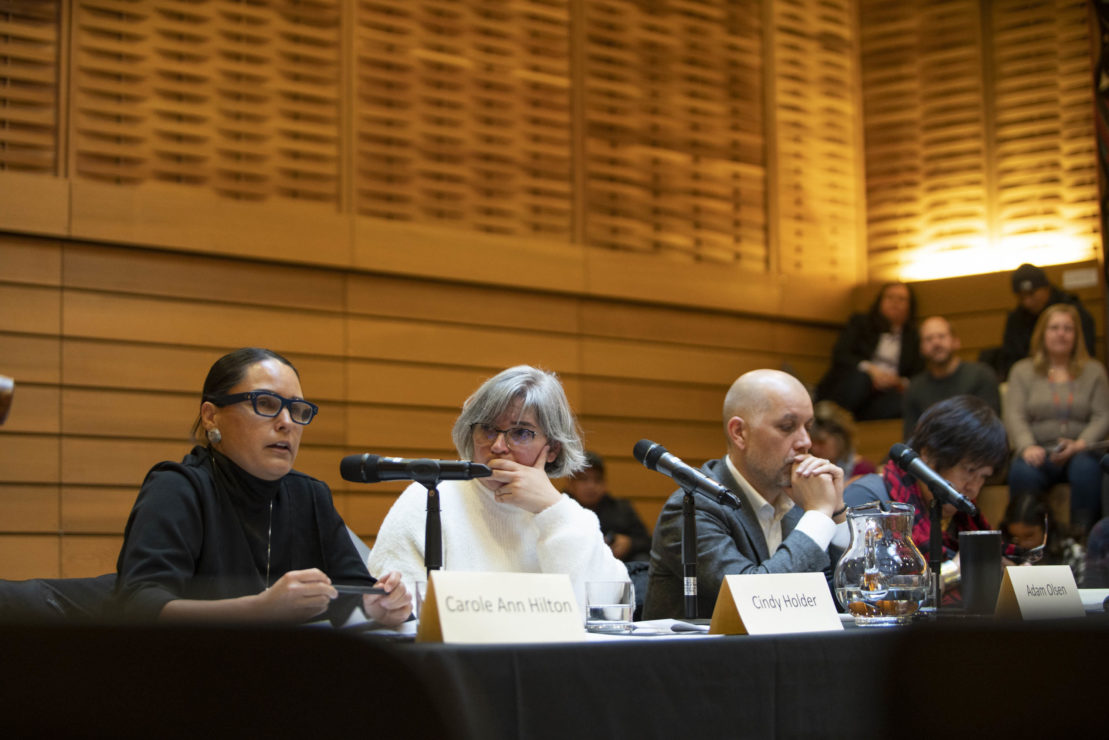Unpacking colonial law in a tense time for Indigenous people

Questions about what it means to be Canada’s first province to pass legislation to implement the United Nations Declaration on the Rights of Indigenous Peoples (UNDRIP) brought together a curious community of 100 at the First Peoples House on Jan. 16. The panel discussion was organized by the Centre for Indigenous Research and Community-Led Engagement (CIRCLE) and the School of Public Administration.
The panel of Indigenous speakers came together to discuss the prospects of the Declaration on the Rights of Indigenous Peoples Act (DRIPA) through which UNDRIP will be implemented. According to lawyer and president of Nuu-chah-nulth Tribal Council Judith Sayers, DRIPA would align nearly 5 000 of B.C.’s provincial laws with UNDRIP.
Jeff Corntassel, associate professor of Indigenous studies at UVic and moderator of the event, began by giving the audience a crash course on UNDRIP.
He reminded the audience of the long history behind UNDRIP, describing how in 1982, the United Nations (UN) Working Group on Indigenous Populations was created. But when Corntassel joined the working group in the late 1990s, he witnessed “a battle over whether we are ‘people’ or ‘peoples’”. Another contested idea in the working group was self-determination.
“Not everything [Indigenous peoples] wanted is in [UNDRIP],” said Sayers. She asserted that this is because UNDRIP wasn’t a declaration by Indigenous peoples, it was a UN declaration on Indigenous peoples’ rights.
In spite of that, Corntassel said that when UNDRIP was adopted in 2007, “there were four notable … countries that voted against it.”
Canada was among those nations.
All four — the other three being the United States, Australia, and New Zealand — have since reversed their opposition.
“[In 2010] Canada … acknowledged the UN Declaration but did not formally endorse all of it. They acknowledged and supported [UNDRIP] in principle,” he said.
This changed in 2016 when Canada endorsed UNDRIP, which led to Nov. 26, 2019 legislation, DRIPA.
However, the path to DRIPA was another long struggle, taking nearly three years.
B.C. Green Party MLA for Saanich North and the Islands, Green Party Interim Leader, and member of Tsartlip First Nation Adam Olsen said that, “[The Green Party] put in our platform that the adoption of UNDRIP was an important thing, it was something that we [would do] if we ever formed government.”
But, when he looked at the platform draft from the previous 2013 election, UNDRIP was listed last in priority. From Olsen’s perspective, this needed to change, “because this is the first relationship that needs to be fixed in this province and in this country.”
But the party shifted its tone after the 2017 provincial elections, when the B.C. Green Party were in talks with the provincial Liberals and NDP. Olsen revealed that he had to remind his Green Party colleagues to uphold their responsibilities to the relationship they had committed themselves to through their platform. He told them, “We need to make sure UNDRIP is a foundational piece of this relationship … There is no relationship if we don’t move this forward in this term.”
Although Olsen did not draft Bill 41 — which would eventually become DRIPA — he told the audience that he “was a thorn” reminding his colleagues that UNDRIP could not be ignored. From his perspective the colonial relationship needed to change.
In spite of the long struggle from Bill 41 to DRIPA, Olsen believes that not only is the work not yet done, it hasn’t started yet. According to him, “the most difficult part is what we have ahead.”








